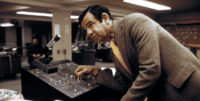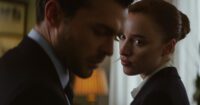Like a lot of R-rated films from before 2000, I first saw Steven Soderbergh’s Out of Sight sometime in 2001 on the USA Network. It was edited for television, but like the best films, I still loved it because I managed to get the true essence of the movie. The language and violence don’t make Out of Sight memorable. It’s the relationships between the characters.
Of course, this wasn’t anything necessarily new. A case can be made that Out of Sight owes its success to the post-Pulp Fiction boom of the mid to late 1990s. Crime films that are less about the crimes and more about hanging out with the characters were a genre unto themselves during this period. Some were more successful than others, mainly when a film wasn’t just trying to do Quentin Tarantino. On the surface, it seems that all you needed was violence, good music, and lots of dialogue, preferably with pop culture references.
Yet even though Out of Sight has these elements, it is so beholden to its own world that it never comes across as Soderbergh doing Tarantino. When a character from Jackie Brown pops up in a scene in the first half of the film, the contrasts between Tarantino and Soderbergh are made even more clear. Both have their own distinct styles, which elevate both the crime pictures before Pulp Fiction and the ones that came after.

Like the Ocean’s trilogy, there’s a heist at the center of Out of Sight, but it’s really just a catalyst to get everyone playing off one another. In a sense, this film doesn’t re-invent anything, but like Tarantino’s work, Soderbergh and company are interested in the people who populate this world of criminality, and the results are entertaining as hell.
Back in 1998, Soderbergh was more than likely best known for a film he’d made nearly a decade earlier, the festival and critical darling Sex, Lies, and Videotape. Throughout the ‘90s, Soderbergh, though, used the success of his first film to make interesting and experimental pictures. Looking back, coming off of a movie as strange as Schizopolis, which finds Soderbergh playing the lead role, it seems like such a left turn for Universal to hire him. Then again, he’d made two films for Gramercy Pictures, then a production label under Universal, so I suppose it’s not the craziest decision in the world.
Still, watching Out of Sight, it’s clear we’re watching a Soderbergh movie, but at the same time, it’s so different than what he’d done prior. Out of Sight feels like the first time Soderbergh became the Soderbergh we now know, the filmmaker who will basically do whatever he wants if given the opportunity. This can result in box office success like the Ocean’s trilogy, as well as a film like Full Frontal.
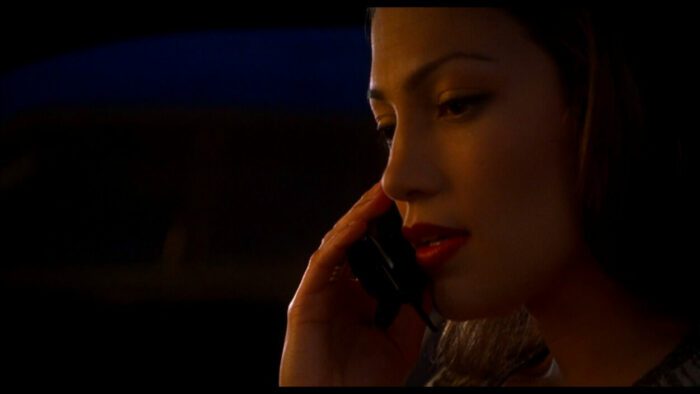
Out of Sight has a hip soundtrack, a cast of famous faces and character actors, an inspired editing style, a strong use of colors to delineate locations, and the willingness to go unusual ways with an otherwise straightforward narrative. For instance, George Clooney’s Jack and Jennifer Lopez’s Karen share an attraction, but this isn’t the usual kind of love story. Is it 100% necessary to the story that it’s told out of order? It doesn’t lose any points for the film, but I do wonder if it’s a case of Soderbergh using the narrative structure of a novel or if it’s him wanting to simply play with the format. Either way, I’m game.
As a director, Soderbergh knows all the tricks, but also, recognizes that his films can’t all be flash and no substance. Like most of his films, I adore the characters in Out of Sight. I’ll get to the two leads in a second, but I cannot find enough hyperbole for the work the actors in this film give us. Whether it’s Don Cheadle playing an off-kilter, though still menacing criminal, Steve Zahn doing his usual (but always entertaining) Steve Zahn character, Ving Rhames proving he’s just so damn good at playing a best friend, or Dennis Farina as Karen’s father who steals every scene he’s in, I can’t get enough.
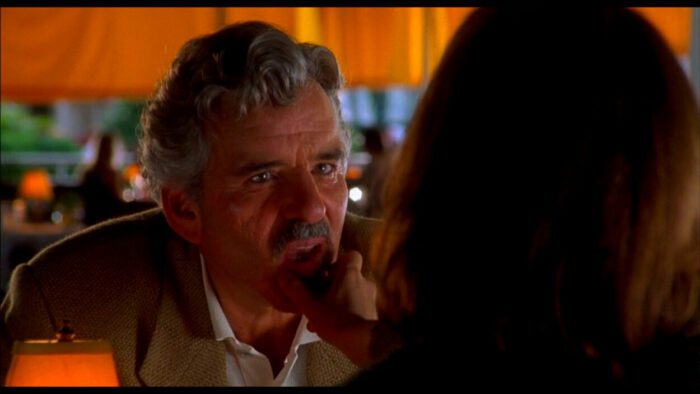
This film could’ve been an hour longer, with nothing but conversations between these characters, and I would’ve eaten it up. I can’t spend too long simply praising, but I haven’t even touched on Catherine Keener, Albert Brooks, Luis Guzman, or even Michael Keaton who shows up in one scene and in B-roll during a news broadcast. Everyone’s great.
And yet George Clooney and Jennifer Lopez still manage to hold my attention every second they’re on screen, whether they’re separate or together. They are electric, and frankly, they’ve never been better. Now, sure, it helps that both are just great looking, the combination of hair, makeup, and lighting doing everything possible to accentuate their features. But, it also must be said that their performances are pitch-perfect.
Honestly, it’s no wonder these two have had solid careers as movie stars. Looks aside, they are both good actors. So much of this film requires them to do subtle work. We have to believe that Karen is falling for Jack, but also that she feels conflicted. Similarly, we have to like Jack, but we also have to believe he’s a criminal who’s done some pretty bad things. These two sell me on their characters so well that I’m on board right away.
Take the first time they meet. If I were to explain this scene to someone, I’m sure they’d find it weird. Simply put, a prisoner escapes prison with the help of his best friend and proceeds to take an armed U.S. marshal hostage. Now, in the hands of Soderbergh, Clooney, and Lopez, it’s a Meet-Cute for the ages. Also, the film is aware of this combination of romance and criminality when Karen tells this to Jack during this scene when they get to talking about movies, specifically Three Days of the Condor:
“You know I never thought it made sense, though. You know the way they got together so quick. I mean romantically.”
Fair enough.
They wind up in the trunk of her car and end up flirting. Clooney’s Jack Foley is quintessential Clooney. He’s a smooth talker, but he’s the kind of smooth talker who can put a cynic at ease. Yes, Karen knows he’s a criminal and that he’s potentially dangerous, but there’s something about his questions and his small jokes that get to her. The scene in the trunk works so well that it’s easy to be surprised when Karen starts taking shots at him when he gets out later. It’s almost like Soderbergh is reminding the audience that although we’re watching two people fall for one another, Jack is a criminal and Karen is the law.
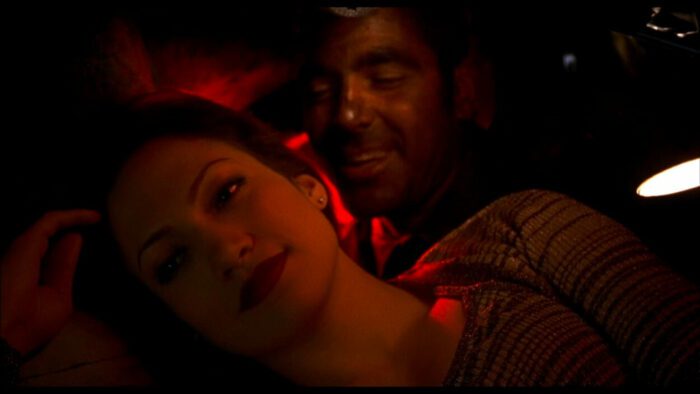
Interestingly enough, this is probably why I’m not surprised near the film’s end when Karen ultimately takes a shot a Jack to prevent him from escaping. On the one hand, I understand the reaction of, “What the heck, Karen? I thought you had fallen for this guy?” I do. Out of Sight is romantic. Just watch that scene in the restaurant intercut with the two of them undressing for one another in a hotel room. The lighting and the snow outside, coupled with the chemistry between these two, I have to admit when something is sexy, and this is sexy.
Sexy and romantic don’t generally go hand in hand, but in this film, I feel like it does. The sexiness is not only the superficial stuff, but the look of the actors, and of the film itself. It’s tied to the story and, more importantly in my opinion, to the characters. Karen turns on Jack, and vice versa. A part of that is how they look. However, they’re attracted to one another because of that ride in the trunk. For whatever reason, these two get along and, given their life choices, they shouldn’t.
I like romances between two people who don’t seem like obvious fits on paper. These two work together, though. Props to the original material from Elmore Leonard and Scott Frank for his screenplay, which was rightfully nominated for an Academy Award that year (the editing, of course, was too). Clooney and Lopez do the heavy lifting on screen, as does everyone working on that set, particularly the director.
Steven Soderbergh’s 1998 film turns 25 this year, but it honestly feels timeless. The filmmakers made the smart move to not show too much of the late ‘90s, which allowed a modern audience to appreciate the film. There aren’t problematic moments, unless you count the love story as being problematic, which would honestly be fair, but there’s a lot to love about this film.
Why, then, doesn’t it get the appreciation it deserves? There are reasons. First, as of this writing, it’s not readily available to stream unless you have Roku or plan to buy or rent it, and honestly, for an older film, it can be difficult for audiences to give something a try if they have to pay for it. Second, Soderbergh has other popular films, such as the Ocean’s trilogy, Sex, Lies, and Videotape, and Traffic so it’s easy to look past this one.
Thankfully, we’ve continued to see solid work from Clooney, Lopez, and Soderbergh over these past 25 years. Clooney not only won an Academy Award for acting but he’s also been nominated for his work behind the camera as well. Lopez has had steady work in music and acting, receiving well-deserved acclaim for her work in 2019’s Hustlers, another crime film that’s more about the characters than the crimes. And Soderbergh has continued to do interesting things will the crime genre, whether we’re talking Logan Lucky or No Sudden Move. However, he has yet to surpass this film.
Still, given its anniversary, it would be nice to see more people talk about Out of Sight. It’s so cool, and sexy, and just plain good. It might not be Soderbergh’s masterpiece, but it’s a more than worthy entry in his filmography.


